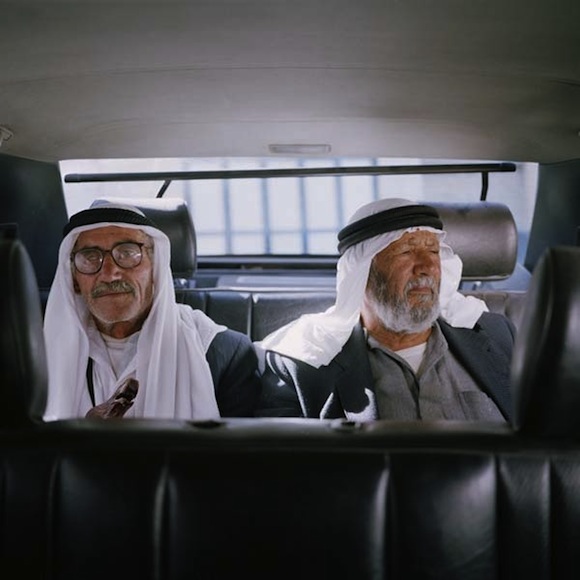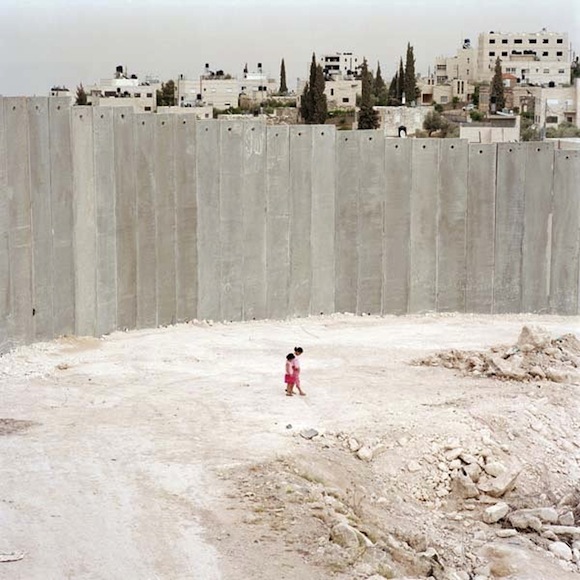In this collection of essays, three young Palestinian photographers and refugees respond to the work of Alessandra Sanguinetti, an Argentinian-American photographer who visited Palestine twice during the second Intifada. Mohammad Al-Azza, Yasmeen Saleem, and Areej Asad were children when Sanguinetti took some of her photographs in their community. Years later, they found these photographs personally and politically resonant. Sanguinetti documented the aftermath of military violence, but she also captured quiet moments of reflection. These writers gravitated to the latter images.
For more about the photography project, “With Our Ideas, We Take Our Portrait,” read Amahl Bishara`s essay "Permission to Caption."
"A Journey to the Past, and Beyond"
Yasmeen Saleem, sixteen years old

[“Abu Munir and Hassan”, Aida Camp, C-Print, 2004. By Alessandra Sanguinetti.]
In this photograph, the gazes of these two old men sitting side by side in a taxi are full of contemplation. “Our story is not yet over. Our case is not yet solved. Are we still here? Have we still not returned to our homes and villages?” Their gazes brim with memories of something lost, of their youth. Everything in this old taxicab references their past, even the black leather seats that coordinate with the two men’s matching clothes. The kafiyya and ’iqal, or black band used to hold the kafiyya in place, represent our heritage. Even though the two men are not looking at each other, or even in the same direction, I sense they are in a deep conversation about a topic familiar to both of them. It is as if they are saying to each other: “We have traveled together, you and I—we dreamed of return, to spend one night of our many nights, full of singing and dabka dancing, with our family and neighbors. Or to spend a day in the fields, taking care of our land, the land that offered us the most delicious olives and olive oil. Will we ever taste a za’tar like that za’tar again? A journey, we have lived, but here we are, right now.” Our memories accompany us. They wound us every day. But our hopes of return will not be diminished, our dream to spend a treasured night on our land.
* * *
"I Don’t Sleep to Dream"
Mohammad Al-Azza, 22 years old
 [“Yusra”, Al-Azza Camp, C-Print, 2004. By Alessandra Sanguinetti.]
[“Yusra”, Al-Azza Camp, C-Print, 2004. By Alessandra Sanguinetti.]
This picture taken by the artist Alessandra Sanguinetti depicts an old woman while she is sleeping. She is my father’s aunt, Hajja Yusra, born in the village of Beit Jibreen, a Palestinian village in the northwest of the Hebron district. The name Beit Jibreen means “the house of the strong,” and she was one of them. In 1948, its residents were evacuated at the hands of the Zionist forces. Beit Jibreen was one village among many depopulated during what has come to be called “Al-Nakba,” or the catastrophe, when the state of Israel was established on Palestinian lands. Hajja Yusra and her family were displaced to the city of Bethlehem, and they settled in Azza Refugee Camp. She grew up there amidst the tents and alleyways of the refugee camp. She had her children and grandchildren there. I used to love to go to her house and sit with her, because she used to tell us stories about Beit Jibreen.
In this picture, Hajja Yusra is sleeping, wearing her dress with its handmade embroidery. Its colors and designs speak to her place of origin, since every village has its own special traditions of embroidery. Wearing it, she is holding onto her heritage and expressing her love for the land. I wonder what Hajja Yusra is thinking.
This photograph expresses so much. The prayer rug underneath her head indicates her piety. The lighting suggests that it was taken around two or three in the afternoon, a perfect time for a rest. The focus on her face and on her hands shows the wrinkles she has earned. We can read time and suffering on her face.
There is a poem by Mahmoud Darwish that begins, “I don’t sleep to dream.” It is a love poem, but it reminds me that there are many strains of Palestinian rest and restlessness. Perhaps Hajja Yusra is hoping that if she sleeps she will wake up on the road back to Beit Jibreen, or maybe she wants to escape from her thoughts and rest her mind a little. But at the same time, the photograph does not evoke a relaxed sleep. Perhaps she is afraid that she will sleep without waking up in Beit Jibreen, where she descended into this world. Perhaps she is sleeping to forget her fear that the new generations will live as refugees, and that they will sleep and wake eternally as refugees. Or that the dream of return will be lost to them.
Some of the Zionist leaders said when they occupied Palestine that the old will die and the young will forget. At the end of October 2011, Al Hajja Yusra passed away. My family and I mourned her loss deeply. Through her life she made us grasp onto our right to return to our villages. Many of our elders have died, but the young continue on the path to return to historic Palestine. We carry the banner of return, and we will not forget our elders.
* * *
"Children’s Memories, Surrounded"
Areej Asad, 16 years old

[“Abu Dis”, C-Print, 2004. By Alessandra Sanguinetti.]
The land: how we long for it. The land behind the separation wall witnessed our joy and sadness. We spent there the most beautiful times of our childhood. Our memories are planted there…There! In days past, when I was a child, I used to say “there” and mean the land that I would play on with my friends, the land that I would walk through. But now I say “there” and mean the land that was taken from our hands.
This photograph by Alessandra Sanguinetti focuses our attention on two girls walking on barren ground next to the separation wall in the city of Abu Dis. It reminds me of this place where I used to spend a lot of time in Aida Refugee Camp in Bethlehem. Even though I live in Doha City, another part of Bethlehem, I go to a center in Aida Camp to practice traditional Palestinian dancing. Today, the scene in the camp is similar to the one in this picture. There is a wall, and there are children walking all day long next to the wall. When I look at this picture and see these two girls, I know there is a connection between them and me. I feel sure they are frustrated by the wall, that they miss an open place to play. In Aida Camp, the wall took the only open space that children from the camp used to use. The two girls in this picture seem as though they are very disappointed. Even though the photographer took the photo from a distance, you can read their sadness in their postures, as clearly as you would in a close-up of their faces. Because of the similarities between Aida Camp and Abu Dis, I feel that I understand the meaning behind this picture, that the separation wall has terrible effects on children.
One day I was going with my friends to the land that has now fallen behind the wall. I went there to play, to have fun. I knew that Israel was building the wall around the camp, but I had thought the construction was far from the land. When we arrived that day, we saw the soldiers uprooting trees. We saw the wall being built piece by piece. We were surprised, and we were angry. At first, we talked a lot about what we saw. But in the end, we returned to the center without speaking. Perhaps the same experience happened to the two girls in the picture. They were going to play, and all of the sudden they did not find the place that carries so many memories for them.
"With Our Ideas, We Take Our Portraits" is a photography discussion group based at Lajee Center, a community-based organization in Aida Refugee Camp, Bethlehem, the West Bank.
Yasmeen Saleem, 16, was born in Amman, Jordan, and continues to live there, but her family is from Beit Mahsir, a village in the Jerusalem district that was destroyed and depopulated in 1948. She hopes to study to become an architect, and she also enjoys writing and photography. She visits the West Bank every year, during which time she is active with Lajee Center.
Mohammad Al-Azza, 22, is the director of the Media Unit at Lajee Center. He is a winner of Al-Awda awards from Badil Resource Center for Palestinian Residency and Refugee Rights for his photography and for his documentary “Everyday Nakba.” This documentary is about the crisis of water in Aida Refugee Camp, where he was born and raised. His family is from the village of Beit Jibreen, in the district of Hebron.
Areej Asad, 16, was born and lives in Bethlehem, Palestine, though her family is from the village of Beit Mahsir. She hopes to study pharmacy, and she enjoys photography, writing, athletics, and Palestinian traditional dance. She has been involved with Lajee Center for many years.
![[“Sadeel and Aboud”, C-Print. By Alessandra Sanguinetti.]](https://kms.jadaliyya.com/Images/357x383xo/Sanguinetti_SadeelAndAboud_small.jpg)
















